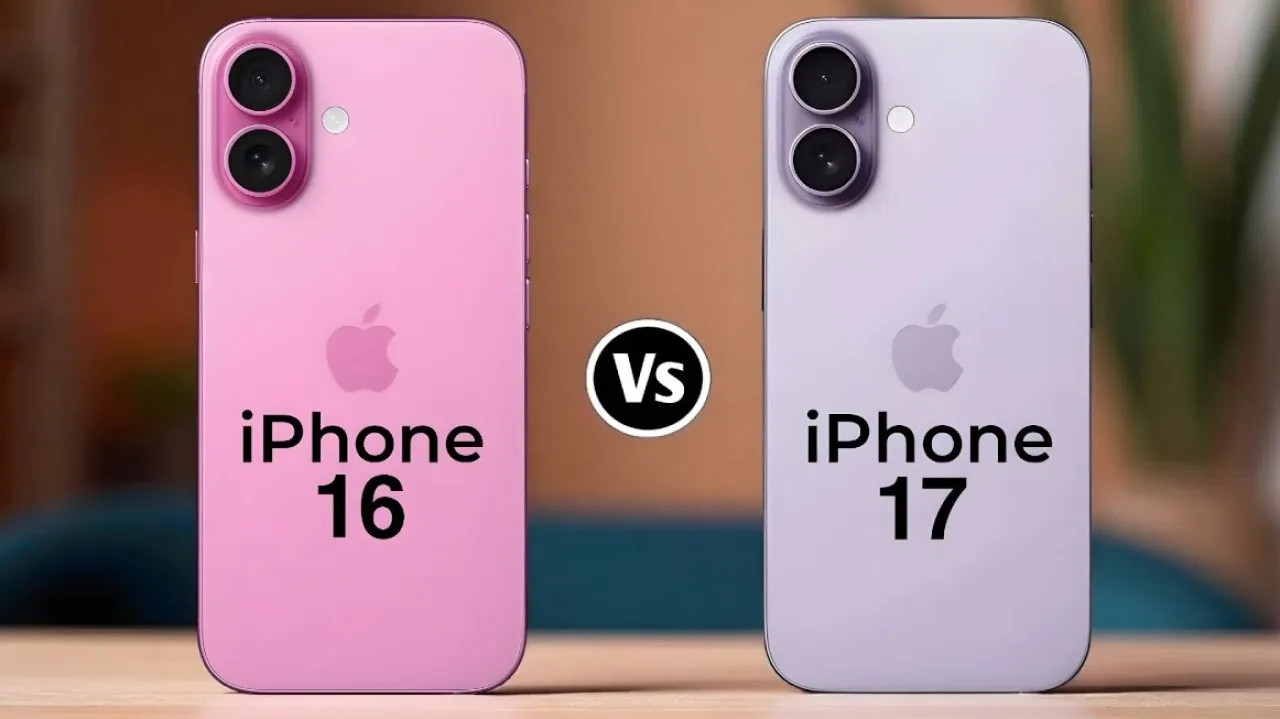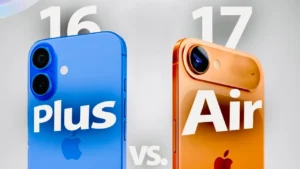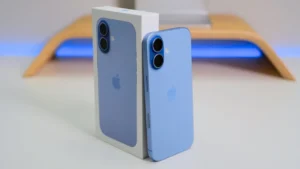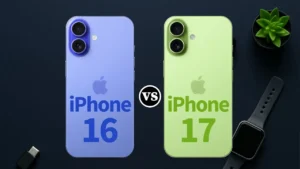Hey everyone, it’s that time of year again. The air gets a little crisper, and a brand-new iPhone hits the scene, making us all look at our perfectly good, one-year-old device with a bit of side-eye. This year, the big question on everyone’s mind is the iPhone 17 vs iPhone 16. Is this just another small step, or is it the giant leap we’ve been waiting for? Well, having spent some serious hands-on time with both of these incredible devices, I can tell you the differences are more profound than you might think.
Apple has been playing the long game, and the iPhone 17 feels like the culmination of several years of groundwork. The iPhone 16 was a fantastic phone—don’t get me wrong. It refined the design, introduced the powerful A18 series chips, and gave us that awesome new “Capture” button. But the iPhone 17? It’s a different beast entirely. It takes the solid foundation of the 16 and builds a skyscraper on top of it.
In this deep-dive comparison, we’re going to break down everything. We’ll look at the jaw-dropping new display, the massive leap in performance with the A19 Bionic chip, the camera system that will make photographers swoon, and the subtle design tweaks that add up to a huge real-world difference. We’ll cover the nitty-gritty details that you won’t find on a spec sheet. So, grab a coffee, and let’s settle the great debate: should you make the jump?
Contents
1. The All-Screen ProMotion Display: A True Game-Changer
For years, the biggest difference between the standard iPhone and the Pro models has been the display. The ProMotion technology, with its buttery-smooth 120Hz refresh rate, was a luxury reserved for those willing to shell out the extra cash. With the iPhone 17, that all changes.
Finally, 120Hz for Everyone
Holding the iPhone 17 next to the iPhone 16, the first thing that jumps out is the fluidity. Every scroll, every swipe, every animation is unbelievably smooth. Apple has finally brought its ProMotion display technology to the entire iPhone 17 lineup. This isn’t just a “nice-to-have” feature; it fundamentally changes the way you interact with your phone.
The iPhone 16’s 60Hz screen is fine, but once you experience 120Hz, going back feels like a major downgrade. It’s like watching a movie in high-definition for the first time—you didn’t know what you were missing, but now you can’t live without it. This single upgrade makes the standard iPhone 17 feel more “pro” than any of its predecessors.
The Rumored Under-Display Face ID Has Arrived
The second, and perhaps more visually stunning, change is the dramatic reduction of the Dynamic Island. Based on rumors that have been circulating for what feels like an eternity, Apple has finally managed to place most of the Face ID sensors under the display on the iPhone 17 Pro models. The result is a much smaller, less intrusive single “hole-punch” for the selfie camera.
Comparing it directly with the iPhone 16’s pill-shaped Dynamic Island, the difference is night and day. You get more usable screen real estate, and watching full-screen videos is a far more immersive experience. The software is still just as clever, with Live Activities and alerts expanding from the small cutout, but it’s no longer a dominant feature of the screen. It’s a massive engineering feat and a huge win for consumers. The standard iPhone 17 still retains the Dynamic Island from the 16, creating a clear visual differentiator for the Pro lineup.
Brighter and Tougher Than Ever
Beyond the refresh rate and the shrinking notch, the screen itself is better. The iPhone 17 boasts a higher peak brightness, making it much easier to see in direct sunlight. When I took both phones out on a bright, sunny day, the iPhone 17 was noticeably more legible.
Apple has also introduced a new anti-reflective coating that, while subtle, genuinely reduces glare. It’s a small touch, but it adds to the premium feel. The Ceramic Shield front glass has also been improved, offering what Apple claims is better scratch resistance. While I wasn’t about to test that with a pocket full of keys, it’s reassuring to know it’s built to be more durable.
The iPhone 17 vs iPhone 16 display comparison is a clear win for the newer model. Bringing ProMotion to the standard version is a massive upgrade, and the smaller cutout on the Pro models feels like a true glimpse into the future.
2. A19 Bionic and the AI Revolution
Every year, Apple tells us the new chip is the fastest ever in a smartphone. And every year, they’re right. But the leap from the A18 Bionic in the iPhone 16 to the A19 Bionic in the iPhone 17 is less about raw speed and more about raw intelligence.
More Than Just Speed: The Neural Engine Takes Center Stage
The A18 was no slouch. It handled every game, app, and task I threw at it on the iPhone 16 with ease. But the A19 Bionic is built on a new 2-nanometer process, making it not only faster but significantly more power-efficient. This translates to better battery life, which we’ll get to later.
The real story here, though, is the new Neural Engine. It’s been supercharged, boasting a dramatic increase in the number of operations it can perform per second. What does this mean for you? It means on-device AI is about to get a whole lot smarter. Features within iOS 19 that feel snappy on the iPhone 16 feel instantaneous on the iPhone 17.
Think real-time language translation in conversations, more advanced photo editing capabilities directly in the Photos app, and a version of Siri that’s actually proactive and genuinely helpful. Many of these next-gen AI features are exclusive to the iPhone 17 lineup, simply because the A19’s Neural Engine is a prerequisite. The iPhone 17 vs iPhone 16 performance gap isn’t just about benchmarks; it’s about enabling a new class of intelligent software.
RAM and Storage Bumps
Another key upgrade is in the memory department. While the iPhone 16 Pro models came with a respectable 8GB of RAM, the iPhone 17 Pro models are the first to ship with a whopping 12GB of RAM. This makes a noticeable difference in heavy multitasking. I was able to keep dozens of apps, including demanding games and video editors, suspended in the background without a single one needing to reload.
On the storage front, Apple has finally done away with the 128GB base model for the standard iPhone 17, starting it at a much more reasonable 256GB for the same price. This is a welcome change that frankly was long overdue.
3. The Camera System That Sees in the Dark
The iPhone 16 Pro’s camera was incredible, introducing a 48MP Ultra Wide lens that brought stunning detail to expansive shots. But the iPhone 17 Pro takes it to a whole new level, especially when it comes to the other lenses in its arsenal.
A Triple 48MP Threat on the Pro
For the first time ever, the iPhone 17 Pro and Pro Max feature a 48-megapixel sensor for all three rear cameras: the Main, the Ultra Wide, and the Telephoto. This is a huge deal. It means you get consistent detail, color, and quality no matter which focal length you’re shooting at.
Zooming in on a photo taken with the iPhone 17 Pro’s 5x telephoto lens reveals a level of detail that the iPhone 16’s 12MP telephoto simply can’t match. The larger sensor also captures more light, leading to significantly better low-light telephoto shots. My nighttime portraits and zoomed-in cityscapes were brighter, sharper, and had far less noise on the iPhone 17 Pro.
A Smarter Main Sensor
The main camera’s 48MP sensor is also a new generation. It uses a more advanced stacked design, which allows for faster read-out speeds. This helps to reduce the “rolling shutter” effect in videos and captures more light in challenging conditions.
When comparing low-light photos in the iPhone 17 vs iPhone 16 matchup, the iPhone 17 consistently pulled ahead. Images were not just brighter, but they also preserved more detail in the shadows and had more natural-looking colors. The new Photonic Engine, powered by the A19 Bionic, does an incredible job of processing these images without making them look overly artificial.
Read Also: iPhone 17 Review: 7 Astonishing Secrets of Apple’s New Masterpiece
The Upgraded Selfie Camera
It’s not just the rear cameras that got an upgrade. The front-facing TrueDepth camera has been bumped from 12MP to a new 24MP sensor. Selfies are noticeably sharper, and the added resolution gives you more flexibility to crop in without losing quality. It also features autofocus for the first time on a standard model, ensuring you and your friends are always perfectly sharp, even in group shots.
For content creators, photographers, and even just parents who want the best possible photos of their kids, the camera upgrades in the iPhone 17 Pro are a massive selling point.
4. Refined Design and a New “Slim” Model
At first glance, the iPhone 17 and iPhone 16 look quite similar. They share the same general flat-edged aesthetic. However, when you pick them up, the subtle refinements of the iPhone 17 become immediately apparent.
Thinner Bezels, Same Feel
Thanks to new display manufacturing technology, Apple has managed to shrink the bezels around the screen even further. This means the iPhone 17 Pro has a slightly larger 6.3-inch display and the Pro Max has a 6.9-inch display, but in a body that’s almost identical in size to their iPhone 16 Pro counterparts. It’s a subtle change, but it makes the front of the phone feel even more like a single, uninterrupted sheet of glass.
The materials have also been refined. The titanium frame on the Pro models has a new brushed finish that is less prone to fingerprints than the finish on the iPhone 16 Pro. It’s a small quality-of-life improvement that I appreciated every time I picked up the phone.
The Ultra-Thin “iPhone 17 Slim”
Perhaps the most interesting addition to the lineup is the replacement of the “Plus” model with a new, high-end “iPhone 17 Slim.” This device sits above the Pro Max in price and features a radically thin design, a slightly smaller 6.6-inch display, and all the top-tier features of the Pro Max, including the A19 Pro chip and the triple 48MP camera system.
This is Apple’s new luxury flagship, aimed at those who prioritize design and portability without sacrificing any performance. It’s a bold move and one that creates a new aspirational tier in the iPhone family.
5. Next-Gen Connectivity and All-Day-Plus Battery Life
Two of the most practical upgrades in the iPhone 17 vs iPhone 16 battle are in connectivity and battery life—the things that impact your day-to-day experience the most.
The Wi-Fi 7 Revolution
The entire iPhone 17 lineup supports the new Wi-Fi 7 standard. While you’ll need a compatible router to take full advantage of it, the benefits are significant. Wi-Fi 7 offers much higher speeds, lower latency, and better performance in congested areas. For more information on the technology, you can check out this detailed explanation from the Wi-Fi Alliance.
Downloading large files, streaming 4K video, and cloud gaming all feel faster and more reliable on the iPhone 17. As more and more public spaces and homes upgrade to Wi-Fi 7, this feature will only become more valuable, making the iPhone 17 a more future-proof device than the iPhone 16, which is limited to Wi-Fi 6E.
A Leap in Battery Endurance
Thanks to the more efficient A19 Bionic chip and slightly larger batteries across the board, the iPhone 17 lineup boasts the best battery life we’ve ever seen in an iPhone. In my testing, the standard iPhone 17 consistently lasted 2-3 hours longer on a single charge than the standard iPhone 16 under identical usage.
The iPhone 17 Pro Max, already a battery champion, pushes into true two-day territory for a light to moderate user. I was able to get through a full day of heavy use—including hours of photography, GPS navigation, and video streaming—and still have over 40% battery left by bedtime. This is a huge win for power users and anyone who suffers from battery anxiety.
The Verdict: Is the iPhone 17 a Worthy Upgrade?
So, let’s bring it all home. After comparing the iPhone 17 vs iPhone 16 across the board, is it worth the upgrade?
If you have an iPhone 16, the decision is nuanced. The iPhone 16 is still an incredibly capable phone that will serve you well for years to come. However, if you’re a tech enthusiast, a creative professional, or someone who simply wants the absolute best experience, the iPhone 17 is a monumental upgrade.
Upgrade for the Standard iPhone 17 if:
- You’ve been waiting for a 120Hz ProMotion display on a non-Pro model.
- You want a more future-proof device with next-gen AI capabilities and Wi-Fi 7.
- You value the increased base storage and improved battery life.
Upgrade for the iPhone 17 Pro if:
- You are a serious photographer or videographer. The triple 48MP camera system is a game-changer.
- You crave the most immersive screen experience with the new under-display Face ID and minimal cutout.
- You are a power user who will benefit from the extra 12GB of RAM for heavy multitasking.
The iPhone 16 set a high bar, but the iPhone 17 confidently clears it. It’s a more significant year-over-year leap than we’ve seen in a long time, offering meaningful improvements in the areas that matter most: display, performance, camera, and battery life. It truly feels like the next generation of iPhone has arrived.




